Accessibility to Food Retailers: The Case of Belo Horizonte, Brazil
Abstract
1. Introduction and Background
2. Data and Methods
2.1. Data Collection
2.2. Definition of Variables and Indexes
2.3. Spatial Pattern Characterization
2.4. Food Systems’ Spatial Analysis
3. Results and Discussion
4. Conclusions
Author Contributions
Funding
Acknowledgments
Conflicts of Interest
References
- United Nations. FAO—Food and Agriculture Organization of the United Nations. Available online: http://www.fao.org/home/en/ (accessed on 17 June 2015).
- United Nations. Global Sustainable Development Report; Department of Economic and Social Affairs: New York, NY, USA, 2016. [Google Scholar]
- Morganti, E.; Gonzalez-Feliu, J. City logistics for perishable products. The case of the Parma’s Food Hub. Case Stud. Transp. Policy 2015, 3, 120–128. [Google Scholar] [CrossRef]
- Oliveira, L.K.; Morganti, E.; Dablanc, L.; Oliveira, R.L.M. Analysis of the potential demand of automated delivery stations for e-commerce deliveries in Belo Horizonte, Brazil. Res. Transp. Econ. 2017, 65, 34–43. [Google Scholar] [CrossRef]
- Cui, J.Q.; Dodson, J.; Hall, P.V. Planning for Urban Freight Transport: An Overview. Transp. Rev. 2015, 35, 583–598. [Google Scholar] [CrossRef]
- González-Feliu, J. Urban logistics and spatial territorial intelligence indicators: State-of-the-art, typology and implications for Latin American cities. Interfases 2018, 011, 136–176. [Google Scholar] [CrossRef]
- Taniguchi, E.; Thompson, R.G.; Yamada, T.; van Duin, R. City Logistics: Network Modelling and Intelligent Transport Systems; Emerald Group Publishing Limited: Bingley, UK, 2001. [Google Scholar]
- Taniguchi, E. City logistics for sustainable and liveable cities. Green Logist. Transp. A Sustain. Supply Chain Perspect. 2015, 151, 49–60. [Google Scholar]
- Heitz, A.; Dablanc, L.; Olsson, J.; Sanchez-diaz, I.; Woxenius, J. Spatial patterns of logistics facilities in Gothenburg, Sweden. J. Transp. Geogr. 2018. Available online: https://www.sciencedirect.com/science/article/abs/pii/S0966692317305380 (accessed on 17 March 2020). [CrossRef]
- Gatta, V.; Marcucci, E.; Le Pira, M. Smart urban freight planning process: Integrating desk, living lab and modelling approaches in decision-making. Eur. Transp. Res. Rev. 2017, 9, 32. [Google Scholar] [CrossRef]
- Browne, M.; Allen, J.; Nemoto, T.; Patier, D.; Visser, J. Reducing Social and Environmental Impacts of Urban Freight Transport: A Review of Some Major Cities. Procedia Soc. Behav. Sci. 2012, 39, 19–33. [Google Scholar] [CrossRef]
- Vierth, I.; Mellin, A.; Karlsson, J.; Karlsson, R.; Johansson, M.; Thompson, R.G.; Wild, D.; Holguin-Veras, J.; Studies, P.T.; Rodrigue, J.-P.; et al. Towards a Land-use and Transport interaction Framework. Transp. Res. Rec. J. Transp. Res. Board 2012, 2269, 1–5. [Google Scholar]
- Vieira, J.G.V.; Fransoo, J.C.; Carvalho, C.D. Freight distribution in megacities: Perspectives of shippers, logistics service providers and carriers. J. Transp. Geogr. 2015, 46, 46–54. [Google Scholar] [CrossRef]
- Pigatto, G.; Machado, J.G.; Negreti, A.; Machado, L. Have you chosen your request? Analysis of online food delivery companies in Brazil. Manag. Res. Rev. 2017, 40, 352–367. [Google Scholar] [CrossRef]
- Herzog, B.O. Urban Freight in Developing Cities Module 1g Sustainable Transport: A Sourcebook for Policy-Makers in Developing Cities; GTZ: Eschborn, Germany, 2009. [Google Scholar]
- O’Brien, T.; Giuliano, G.; Dablanc, L.; Holliday, K. Synthesis of Freight Research in Urban. Transportation Planning; Transportation Research Board: Washington, DC, USA, 2016; ISBN 978-0-309-25908-8. [Google Scholar]
- Morganti, E. Urban Food Planning, City Logistics and Sustainability: The Role of the Wholesale Produce Market. The Cases of Parma and Bologna Food Hubs. Ph.D. Thesis, Université de Bologne, Bologna, Italy, 2011. [Google Scholar]
- Rodrigue, J.-P.; Comtois, C.; Slack, B. The Geography of Transport Systems; Routledge: London, UK, 2006. [Google Scholar]
- Morganti, E. Urban food planning and transport sustainability: A case study in Parma, Italy. 2011. Available online: https://halshs.archives-ouvertes.fr/halshs-00907815/ (accessed on 17 March 2020).
- Lopes, A.S.; Loureiro, C.F.G.; Van Wee, B. LUTI operational models review based on the proposition of an a priori ALUTI conceptual model. Transp. Rev. 2019, 39, 204–225. [Google Scholar] [CrossRef]
- Macário, R. Access as a social good and as an economic good: Is there a need of paradigm shift. In Urban Access for the 21 st Century, Finance and Governance Models for Transport Infrastructures; Sclar, E.D., Lönnroth, M., Wolmar, C., Eds.; Taylor & Francis: New York, NY, USA, 2014; pp. 87–115. [Google Scholar]
- Banister, D. The sustainable mobility paradigm. Transp. Policy 2008, 15, 73–80. [Google Scholar] [CrossRef]
- Gonzalez-Feliu, J.; Peris-Pla, C. Impacts of retailing attractiveness on freight and shopping trip attraction rates. Res. Transp. Bus. Manag. 2017, 24, 49–58. [Google Scholar] [CrossRef]
- Gardrat, M.; Serouge, M.; Toilier, F.; Gonzalez-Feliu, J. Simulating the Structure and Localization of Activities for Decision Making and Freight Modelling: The SIMETAB Model. Procedia Soc. Behav. Sci. 2014, 125, 147–158. [Google Scholar] [CrossRef]
- Gonzalez-Feliu, J.; Salanova Grau, J.M.; Beziat, A. A location-based accessibility analysis to estimate the suitability of urban consolidation facilities. Int. J. Urban Sci. 2014, 18, 166–185. [Google Scholar] [CrossRef]
- Giuliano, G.; Kang, S.; Yuan, Q. Spatial Dynamics of the Logistics Industry and Implications for Freight Flows; UC Davis: National Center for Sustainable Transportation, 2016; Available online: https://escholarship.org/uc/item/94h6t7s9 (accessed on 17 March 2020).
- Giuliano, G.; Kang, S. Spatial dynamics of the logistics industry: Evidence from California. J. Transp. Geogr. 2018, 66, 248–258. [Google Scholar] [CrossRef]
- Holguín-Veras, J.; Ramírez-Ríos, D.G.; Encarnación, T.; Gonzalez-Feliu, J.; Caspersen, E.; Rivera-González, C.; Gonzalez-Calderon, C.A.; Lima, R.d.S. Metropolitan Economies and the Generation of Freight and Service Activity: An International Perspective. In Urban Logistics: Management, Policy and Innovation in a Rapidly Changing Environment; Browne, M., Behrends, S., Woxenius, J., Giuliano, G., Holguín-Veras, J., Eds.; Kogan Page Publishers: London, UK, 2018; p. 392. [Google Scholar]
- van Wee, B. Accessible accessibility research challenges. J. Transp. Geogr. 2016, 51, 9–16. [Google Scholar] [CrossRef]
- Lin, L.; Han, H.; Yan, W.; Nakayama, S.; Shu, X. Measuring Spatial Accessibility to Pick-Up Service Considering Differentiated Supply and Demand: A Case in Hangzhou, China. Sustainability. 2019, 11, 3448. [Google Scholar] [CrossRef]
- Geurs, K.T.; van Wee, B. Accessibility evaluation of land-use and transport strategies: Review and research directions. J. Transp. Geogr. 2004, 12, 127–140. [Google Scholar] [CrossRef]
- Garcia, C.S.H.F.; Macário, M.d.R.M.R.; Menezes, E.D.d.A.G.; Loureiro, C.F.G. Strategic Assessment of Lisbon’s Accessibility and Mobility Problems from an Equity Perspective. Netw. Spat. Econ. 2018, 18, 415–439. [Google Scholar] [CrossRef]
- Hansen, W.G. How Accessibility Shapes Land Use. J. Am. Plan. Assoc. 1959, 25, 73–76. [Google Scholar] [CrossRef]
- Boisjoly, G.; El-Geneidy, A.M. How to get there? A critical assessment of accessibility objectives and indicators in metropolitan transportation plans. Transp. Policy 2017, 55, 38–50. [Google Scholar] [CrossRef]
- Pereira, R.H.M.; Banister, D.; Schwanen, T.; Wessel, N. Distributional effects of transport policies on inequalities in access to opportunities in Rio de Janeiro. J. Transp. Land Use 2019, 12, 741–764. [Google Scholar] [CrossRef]
- Widener, M.J.; Minaker, L.; Farber, S.; Allen, J.; Vitali, B.; Coleman, P.C.; Cook, B. How do changes in the daily food and transportation environments affect grocery store accessibility? Appl. Geogr. 2017, 83, 46–62. [Google Scholar] [CrossRef]
- Crush, J.; Frayne, B. Supermarket expansion and the informal food economy in Southern African cities: Implications for urban food security. J. S. Afr. Stud. 2011, 37, 781–802. [Google Scholar] [CrossRef]
- Fancello, G.; Paddeu, D.; Fadda, P. Investigating last food mile deliveries: A case study approach to identify needs of food delivery demand. Res. Transp. Econ. 2017, 65, 56–66. [Google Scholar] [CrossRef]
- Paddeu, D.; Fadda, P.; Fancello, G.; Parkhurst, G.; Ricci, M. Reduced Urban traffic and emissions within Urban consolidation centre schemes: The case of Bristol. Transp. Res. Procedia 2014, 3, 508–517. [Google Scholar]
- Gonzalez-Feliu, J.; Peris-Pla, C. Impacts of retailing land use on both retailing deliveries and shopping trips: Modelling framework and decision support system. IFAC-PapersOnLine 2018, 51, 606–611. [Google Scholar] [CrossRef]
- Marcucci, E.; Gatta, V. Investigating the potential for off-hour deliveries in the city of Rome: Retailers’ perceptions and stated reactions. Transp. Res. Part A Policy Pract. 2017, 102, 142–156. [Google Scholar] [CrossRef]
- Morganti, E.; Seidel, S.; Blanquart, C.; Dablanc, L.; Lenz, B. The Impact of E-commerce on Final Deliveries: Alternative Parcel Delivery Services in France and Germany. Transp. Res. Procedia 2014, 4, 178–190. [Google Scholar] [CrossRef]
- Bjørgen, A.; Bjerkan, K.Y.; Hjelkrem, O.A. E-groceries: Sustainable last mile distribution in city planning. 2019. Available online: https://www.sciencedirect.com/science/article/pii/S0739885919303294 (accessed on 17 March 2020).
- Saskia, S.; Mareï, N.; Blanquart, C. Innovations in e-grocery and Logistics Solutions for Cities. Transp. Res. Procedia 2016, 12, 825–835. [Google Scholar] [CrossRef]
- Mkansi, M.; Nsakanda, A.L. Leveraging the physical network of stores in e-grocery order fulfilment for sustainable competitive advantage. 2019. Available online: https://www.sciencedirect.com/science/article/pii/S0739885919303026 (accessed on 17 March 2020).
- Aljohani, K.; Thompson, R.G. The impacts of relocating a logistics facility on last food miles – The case of Melbourne’s fruit & vegetable wholesale market. Case Stud. Transp. Policy 2018, 6, 279–288. [Google Scholar]
- Tong, D.; Ren, F.; Mack, J. Locating farmers’ markets with an incorporation of spatio-temporal variation. Socioecon. Plann. Sci. 2012, 46, 149–156. [Google Scholar] [CrossRef]
- Zhang, H.; Xiong, Y.; He, M.; Qu, C. Location Model for Distribution Centers for Fulfilling Electronic Orders of Fresh Foods under Uncertain Demand. 2017. Available online: https://www.hindawi.com/journals/sp/2017/3423562/ (accessed on 17 March 2020).
- Durand, B.; Gonzalez-Feliu, J. Urban Logistics and E-Grocery: Have Proximity Delivery Services a Positive Impact on Shopping Trips? Procedia - Soc. Behav. Sci. 2012, 39, 510–520. [Google Scholar] [CrossRef]
- Cagliano, A.C.; Gobbato, L.; Tadei, R.; Perboli, G. ITS for e-grocery business: The simulation and optimization of Urban logistics project. Transp. Res. Procedia 2014, 3, 489–498. [Google Scholar] [CrossRef]
- Belo Horizonte, C.H. Statistics and Indicators. Dashboard. 2017. Available online: https://prefeitura.pbh.gov.br/estatisticas-e-indicadores (accessed on 10 March 2018).
- Belo Horizonte, C.H. Municipal Register of Contributors. 2017. Available online: http://portalpbh.pbh.gov.br/pbh/ecp/comunidade.do?evento=portlet&pIdPlc=ecpTaxonomiaMenuPortal&app=cmc&tax=29098&lang=pt_BR&pg=6020&taxp=0& (accessed on 10 May 2018).
- IBGE—Brazilian Institute for Geography and Statistics. Demographic Census 2010; IBGE: Rio de Janeiro, Spain, 2011. Available online: http://www.ibge.gov.br/home/estatistica/populacao/censo2010/caracteristicas_da_populacao/resultados_do_universo.pdf (accessed on 1 July 2013).
- OpenStreetMap contributors Belo Horizonte street network. Available online: https://www.openstreetmap.org (accessed on 1 January 2018).
- Kedia, A.; Kusumastuti, D.; Nicholson, A. Establishing collection and delivery points to encourage the use of active transport: A case study in New Zealand using a consumer-centric approach. Sustainability 2019, 11, 6255. [Google Scholar] [CrossRef]
- Oliveira, L.K.; Oliveira, R.L.M.; De Sousa, L.T.M.; De Paula Caliari, I.; De Oliveira Leite Nascimento, C. Analysis of accessibility from collection and delivery points: Towards the sustainability of the e-commerce delivery. Urbe 2019, 11, 1–17. [Google Scholar] [CrossRef]
- Garber, N.J.; Hoel, L.A. Traffic and Highway Engineering; CL Engineering: Toronto, ON, Canada, 2014. [Google Scholar]
- Ryeng, E.O.; Haugen, T.; Grønlund, H.; Overå, S.B. Evaluating Bluetooth and Wi-Fi Sensors as a Tool for Collecting Bicycle Speed at Varying Gradients. Transp. Res. Procedia 2016, 14, 2289–2296. [Google Scholar] [CrossRef]
- Dijkstra, E.W. A note on two problems in connexion with graphs. Math 1959, 1, 269–271. Available online: https://www.cs.yale.edu/homes/lans/readings/routing/dijkstra-routing-1959.pdf (accessed on 17 March 2020). [CrossRef]
- Kai, N.; Yao-ting, Z.; Yue-peng, M. Shortest Path Analysis Based on Dijkstra’s Algorithm in Emergency Response System. Telkomnika Indones. J. Electr. Eng. 2014, 12, 3476–3482. [Google Scholar] [CrossRef]
- Aziz, S.; Ngui, R.; Lim, Y.A.L.; Sholehah, I.; Nur Farhana, J.; Azizan, A.S.; Wan Yusoff, W.S. Spatial pattern of 2009 dengue distribution in Kuala Lumpur using GIS application. Trop. Biomed. 2012, 29, 113–120. [Google Scholar] [PubMed]
- Longley, P.; Iba, W. Average-Case Analysis of a Nearest Neighbor Algorithm. In Proceedings of the Thirteenth International Joint Conference on Artificial Intelligence, Chambéry, France, 28 August–3 September 1993. [Google Scholar]
- Krause, E.F. Taxicab geometry; Dover and Addison-Wesley Publishing Company: Menlo Park, CA, USA, 1986; ISBN 978-0-486-25202-5. [Google Scholar]
- Longley, P.A.; Goodchild, M.F.; Maguire, D.J.; Rhind, D.W. Geographical Information Systems and Science; John Wiley & Sons: Hoboken, NJ, USA, 2011; Volume 83, ISBN 0470870001. [Google Scholar]
- Manolopoulos, Y.; Papadopoulos, A.N.; Vassilakopoulos, M.G. Spatial Databases: Technologies, Techniques and Trends; IGI Global: Hershey, PA, USA, 2005; ISBN 1591403898. [Google Scholar]
- Anselin, L.; Syabri, I.; Kho, Y. An Introduction to Spatial Data Analysis. Geogr. Anal. 2006, 38, 5–22. [Google Scholar] [CrossRef]
- Anselin, L. Under the hood Issues in the specification and interpretation of spatial regression models. Agric. Econ. 2002, 27, 247–267. [Google Scholar] [CrossRef]
- Anson, R.W.; Ormeling, F.J. Basic Cartography: For Students and Technicians, Exercise Manual; Elsevier: London, UK, 2013; ISBN 9781483257129. [Google Scholar]
- Melecky, L. Spatial Autocorrelation Method for Local Analysis of The EU. Procedia Econ. Financ. 2015, 23, 1102–1109. [Google Scholar] [CrossRef]
- Moran, B.Y.P.A.P. Notes on Continuous Stochastic Phenomena. Available online: https://academic.oup.com/biomet/article-abstract/37/1-2/17/194868?redirectedFrom=fulltext (accessed on 17 March 2020).
- Banerjee, A.; Singh, A.K.; Chaurasia, H. An exploratory spatial analysis of low birth weight and its determinants in India. 2020. Available online: https://www.sciencedirect.com/science/article/abs/pii/S2213398420300142 (accessed on 17 March 2020).
- Anselin, L.; Anselin, L. Exploring Spatial Data with GeoDa. Geography. 2005. Available online: http://www.csiss.org/clearinghouse/GeoDa/geodaworkbook.pdf (accessed on 17 March 2020).
- Tepanosyan, G.; Sahakyan, L.; Zhang, C.; Saghatelyan, A. The application of Local Moran’s I to identify spatial clusters and hot spots of Pb, Mo and Ti in urban soils of Yerevan. Appl. Geochemistry 2019, 104, 116–123. [Google Scholar] [CrossRef]
- Zhang, C.; Luo, L.; Xu, W.; Ledwith, V. Use of local Moran’s I and GIS to identify pollution hotspots of Pb in urban soils of Galway, Ireland. Sci. Total Environ. 2008, 398, 212–221. [Google Scholar] [CrossRef]
- Guo, L.; Ma, Z.; Zhang, L. Comparison of bandwidth selection in application of geographically weighted regression: A case study. Can. J. For. Res. 2008, 38, 2526–2534. [Google Scholar] [CrossRef]
- Dutko, P.; Ver Ploeg, M.; Farrigan, T. Characteristics and Influentialfactors of Food Deserts. Available online: https://ageconsearch.umn.edu/record/262229/ (accessed on 17 March 2020).
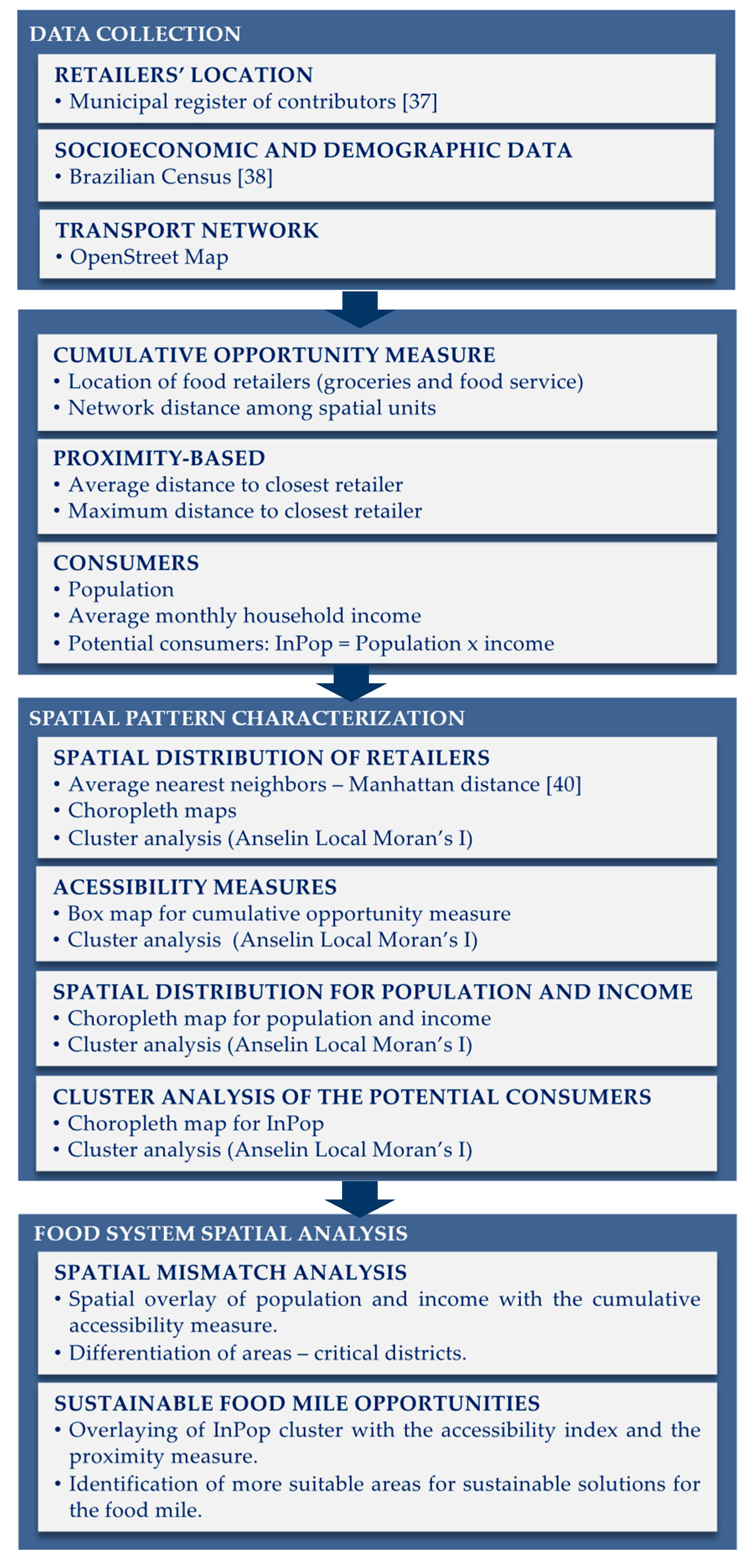



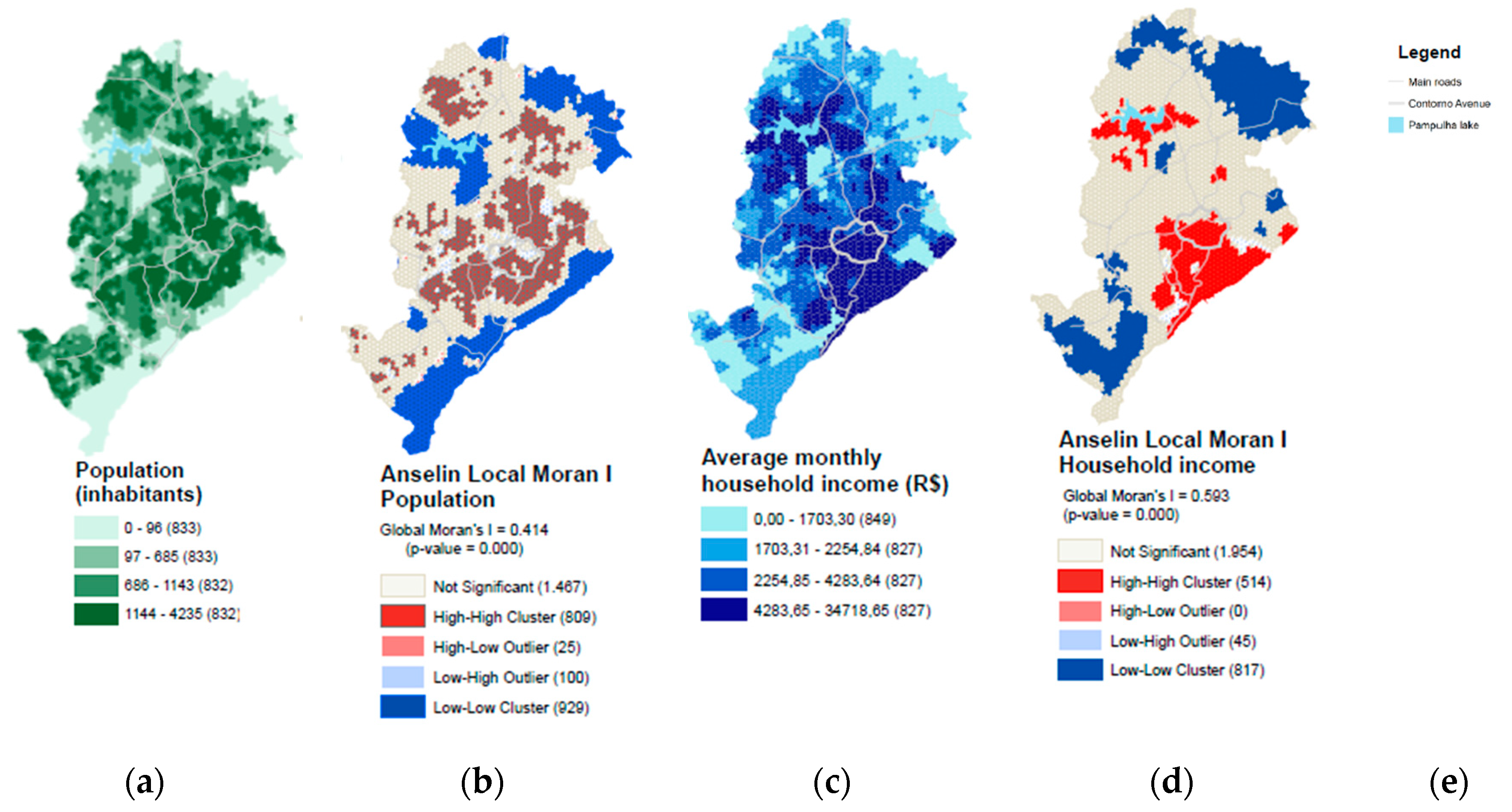
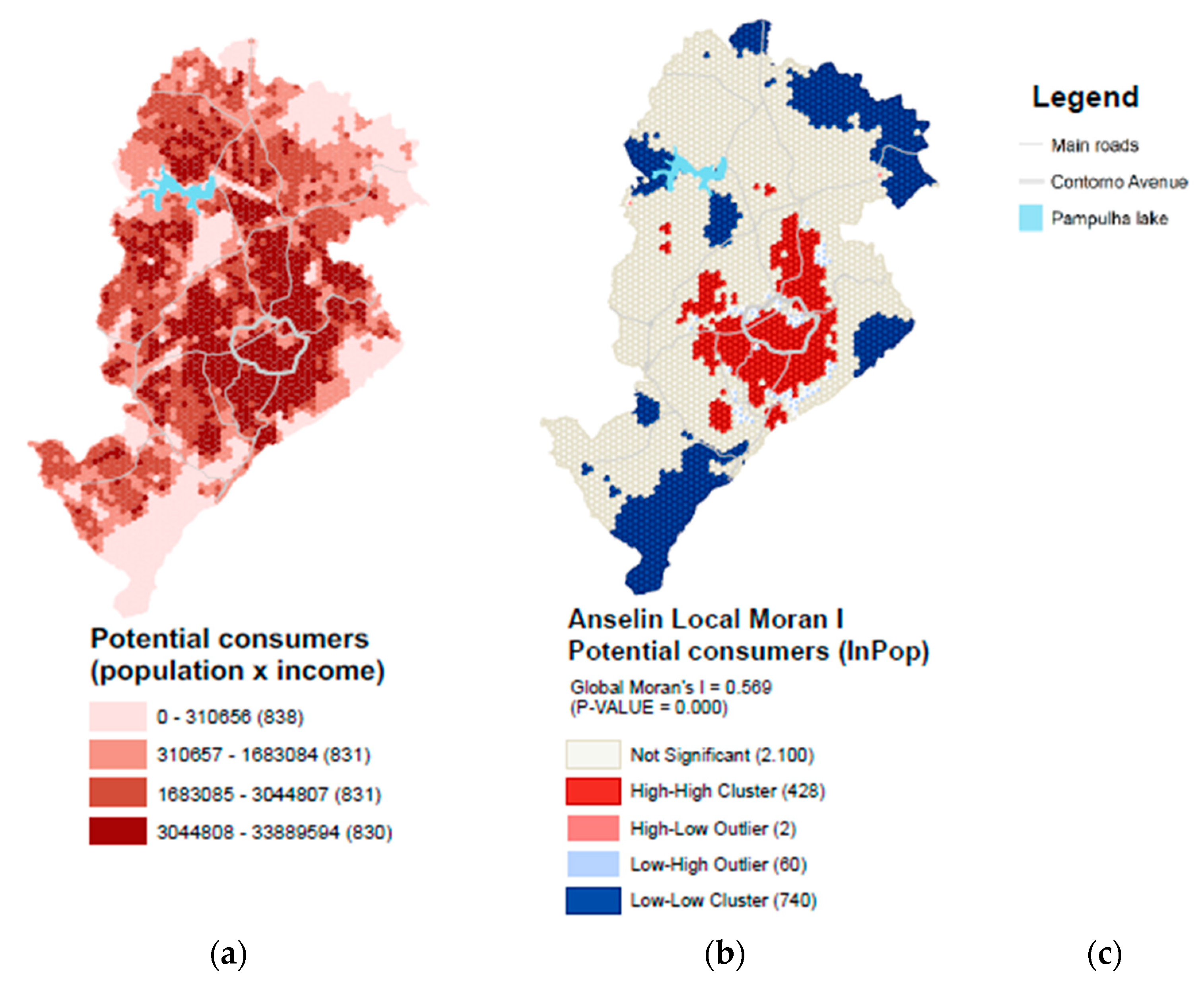
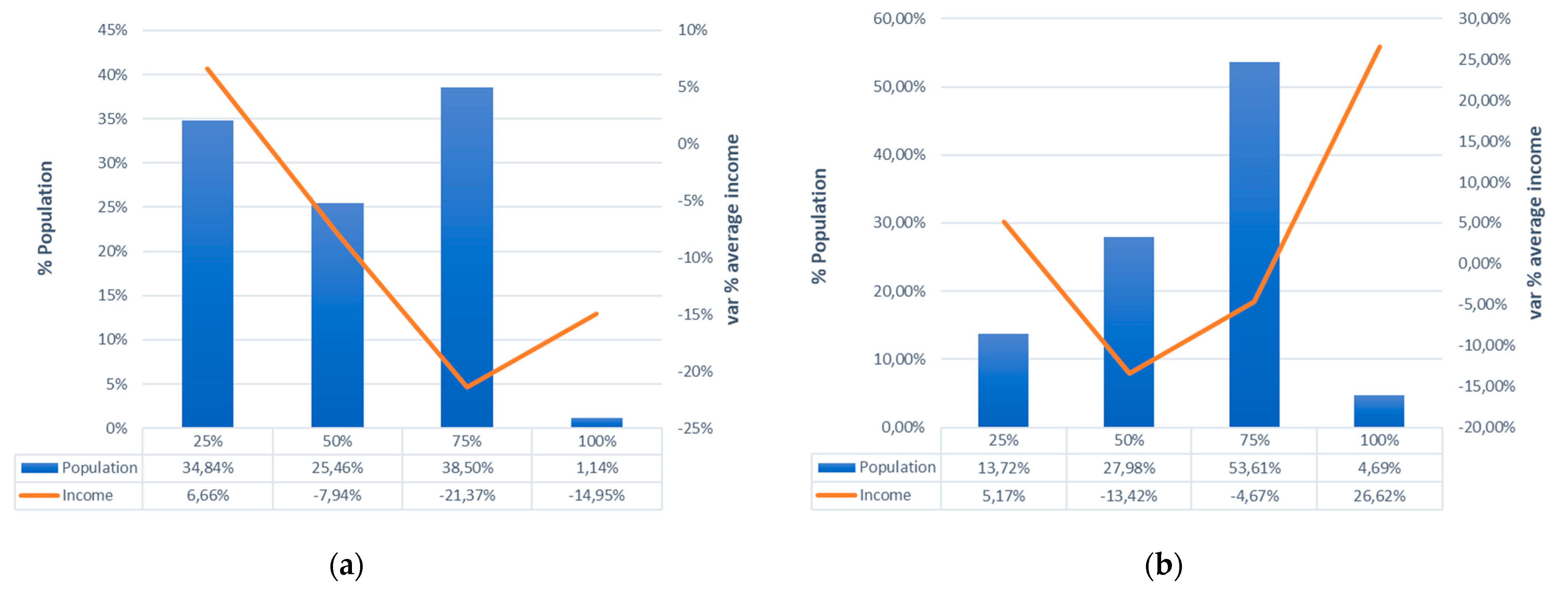
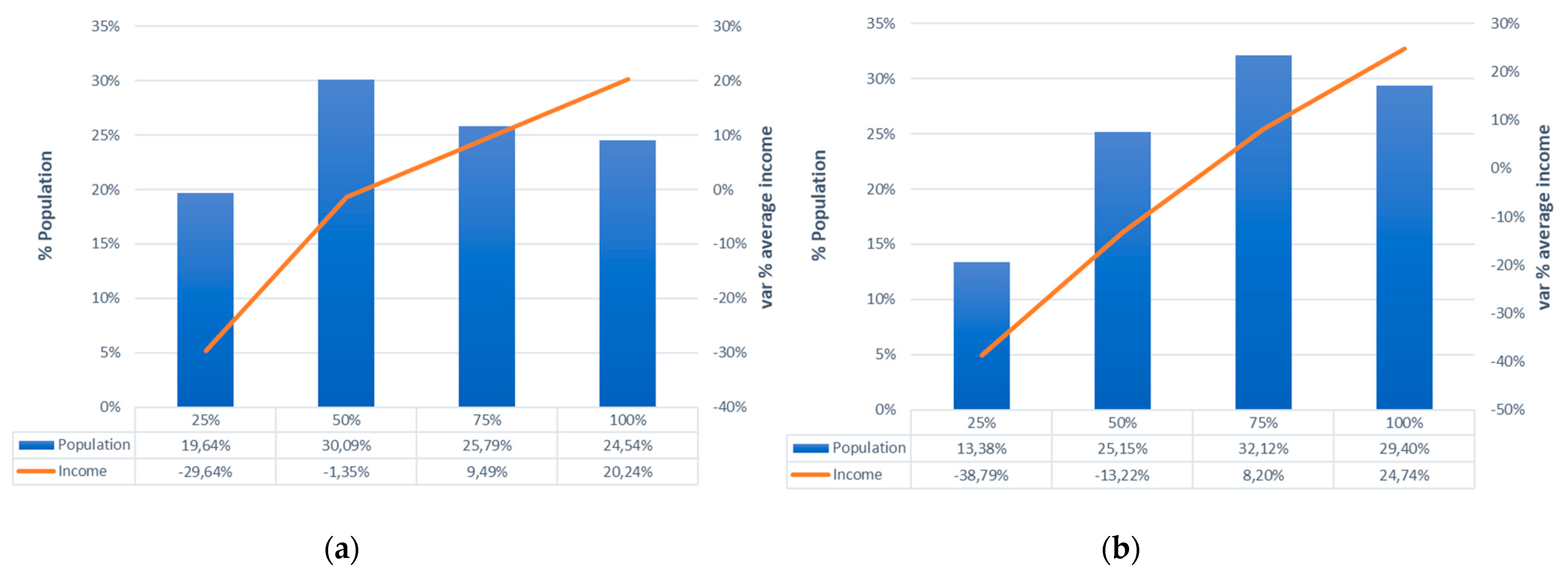
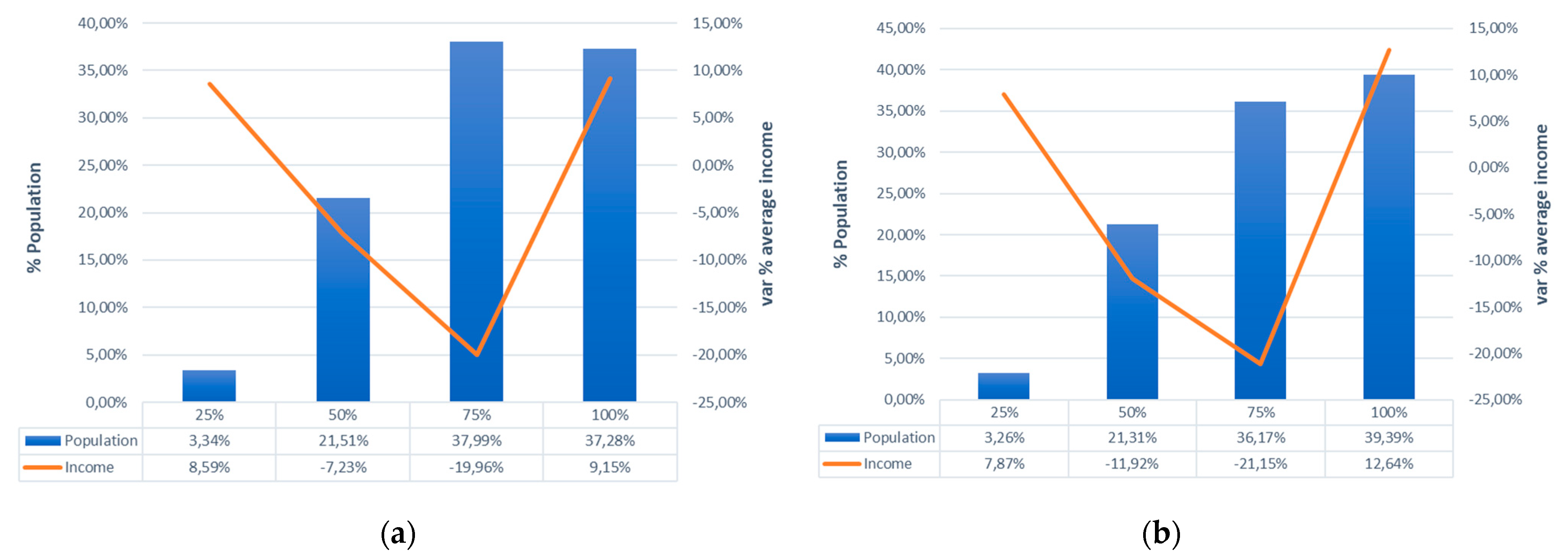
| Group | Category | Number of Retailers | Stores Density (Stores/km2) | Number of Stores per Capita (Stores/1000 Inhabitants) | Spatial Pattern | p-Value |
|---|---|---|---|---|---|---|
| Food Service | Restaurants | 4231 | 12.8 | 1.7 | Clustered | 0 |
| Cafes and bars | 5822 | 17.6 | 2.3 | Clustered | 0 | |
| Bakeries | 1232 | 3.7 | 0.5 | Clustered | 0 | |
| Groceries | Local markets | 2111 | 6.4 | 0.8 | Clustered | 0 |
| Supermarkets | 372 | 1.1 | 0.1 | Clustered | 0 | |
| Hypermarkets | 23 | 0.1 | 0.009 | Dispersed | 0.000057 | |
| Fresh food | 1131 | 3.4 | 0.5 | Clustered | 0 |
| Attribute | Grocery Retailers | Food Service Facilities |
|---|---|---|
| Population (% out of municipality) | 599,217 (25%) | |
| Income (4.50 Brazilian real ~ 1 US$) | 7274.08 | |
| Average distance to the closest facility from each hexagon (m) | 263 | 147 |
| Maximum distance to the closest facility from each hexagon (m) | 1483 | 1071 |
| The average number of facilities within a 500-meter threshold from each hexagon | 6.57 | 87.75 |
| The average number of facilities within a 1000-meter threshold from each hexagon | 28.44 | 114.07 |
© 2020 by the authors. Licensee MDPI, Basel, Switzerland. This article is an open access article distributed under the terms and conditions of the Creative Commons Attribution (CC BY) license (http://creativecommons.org/licenses/by/4.0/).
Share and Cite
Oliveira, R.L.M.d.; Garcia, C.S.H.F.; Góes Pinto, P.H. Accessibility to Food Retailers: The Case of Belo Horizonte, Brazil. Sustainability 2020, 12, 2654. https://doi.org/10.3390/su12072654
Oliveira RLMd, Garcia CSHF, Góes Pinto PH. Accessibility to Food Retailers: The Case of Belo Horizonte, Brazil. Sustainability. 2020; 12(7):2654. https://doi.org/10.3390/su12072654
Chicago/Turabian StyleOliveira, Renata Lúcia Magalhães de, Camila Soares Henrique Fontanele Garcia, and Paulo Henrique Góes Pinto. 2020. "Accessibility to Food Retailers: The Case of Belo Horizonte, Brazil" Sustainability 12, no. 7: 2654. https://doi.org/10.3390/su12072654
APA StyleOliveira, R. L. M. d., Garcia, C. S. H. F., & Góes Pinto, P. H. (2020). Accessibility to Food Retailers: The Case of Belo Horizonte, Brazil. Sustainability, 12(7), 2654. https://doi.org/10.3390/su12072654





